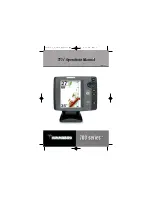
The range of the graphic display is shown to the right of the
graphic information. The upper number is 0 indicating the
surface of the water, the lower number is one of the 9
ranges available which best matches the depth of the
water. As the depth of the water changes, the range
changes as necessary in order to retain a bottom
representation onscreen.
When in Auto mode, the horizontal line at the top of the
graphics area is the 0 line which represents the surface of
the water. Occasionally there will be a gap in this line. This
gap indicates that the unit is updating the display even if the
bottom is not visible on-screen, or if the bottom information
is not changing.
The graphic representation of the bottom may vary
considerably depending on the composition and regularity of the bottom surface (see Interpreting
the Onscreen Information). Any sonar return which is determined to be not a part of the bottom is
shown between the surface and the bottom. If this return is determined to be a fish, one of
several fish shapes is drawn which indicate size, depth, and location of the fish (see Interpreting
the On-screen Information).
INTERPRETING THE ON-SCREEN INFORMATION
Figure B shows a typical view you can expect to see on-water.
New sonar information appears on the right side of the graphic
area of the display and moves to the left as new information is
displayed.
The ProAngler automatically selects the appropriate depth
range to show the depth of water beneath the transducer. This
range is selected so that the bottom representation is typically
shown about 2/3 down the display.
The graphic depiction of the bottom provides the user with an
effective tool for understanding the composition of the bottom.
If the bottom is hard and smooth, the bottom depiction is
narrow and dense. If the bottom is soft mud or sand, the
depiction will be thick and less dense. This indicates that much
of the signal is absorbed by the soft bottom. If the bottom is
rocky or rugged in composition, the depiction is of varying
density and textured in appearance.
Wave action also affects the bottom depiction. Remember that the information drawn is a
distance measurement, so if the boat is moving up and down over flat bottom, the bottom
depiction often appears in regular variations which match wave timing.
Structure is defined as any object physically attached to the bottom. The sonar configuration of
the ProAngler is optimized to give the most accurate depiction of bottom structure possible.
Grass, trees, stumps, wrecks or other debris are accurately displayed, however the depiction of
these objects varies with boat speed and direction. The best way to learn to interpret structure is
to operate the ProAngler over a variety of known conditions and experiment with user functions to
best represent those conditions on-screen.




























